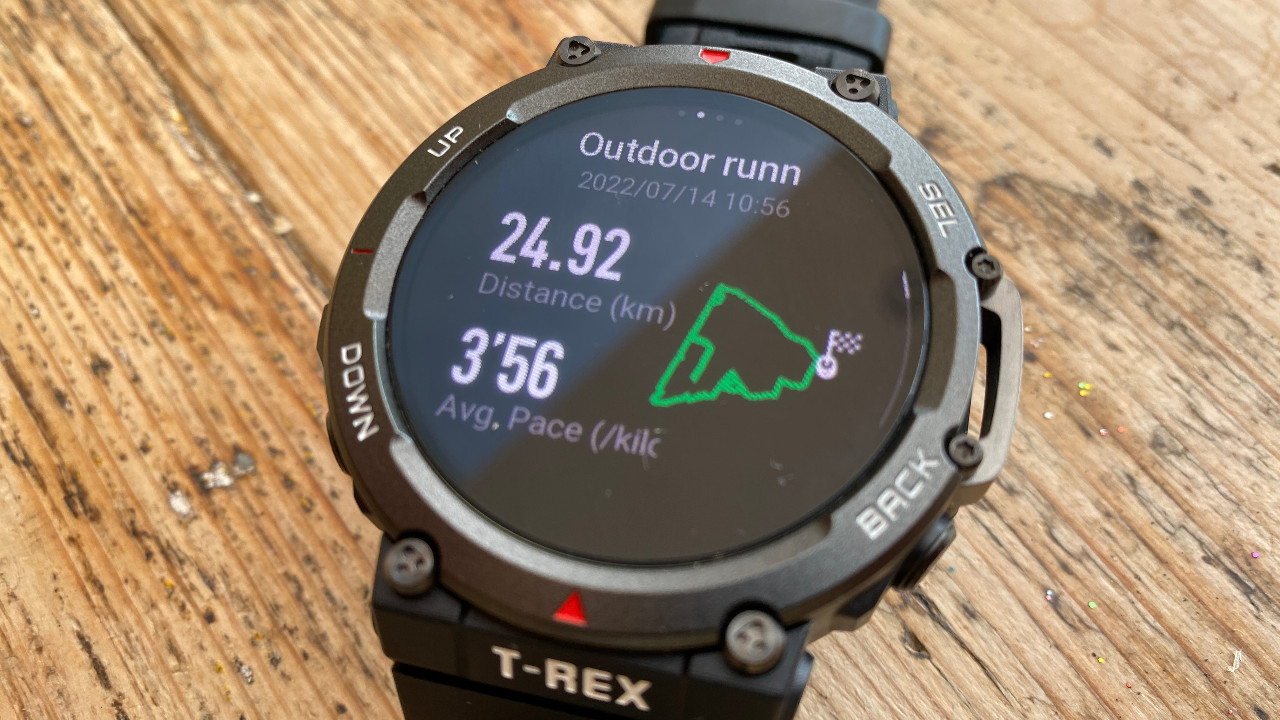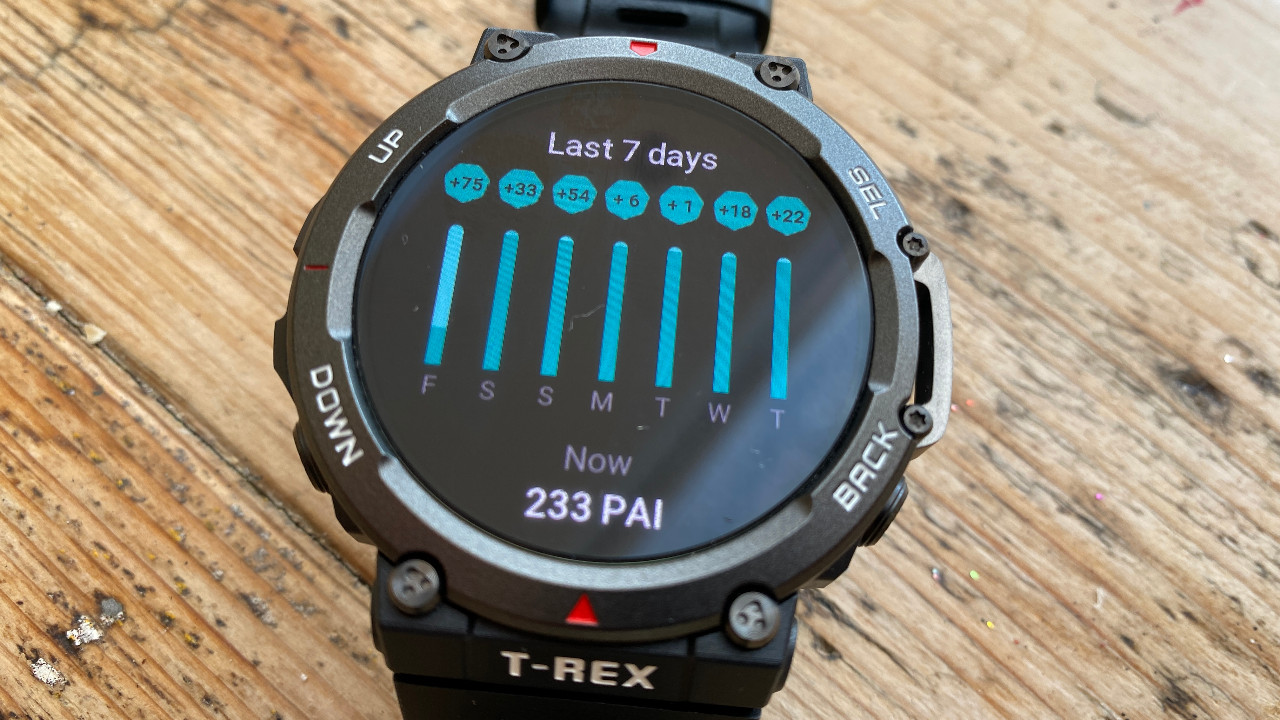Our Verdict
The Amazfit T-Rex 2 is a great option for those who want a GPS sports watch with a smartwatch screen, and its hardy design makes it a cheaper alternative to the Garmin Instinct 2.
For
- Great value
- AMOLED screen
- Long battery life
Against
- Screen can be hard to read in sunlight
- Design won’t suit everyone
- Navigation features not ready at launch
- Can’t pair external sensors
You can trust Coach
Amazfit has a history of making surprisingly good trackers that undercut the competition, but the bewildering array of models can be off-putting. The T-Rex 2 stands out as the top option for sporty users and one that can genuinely compete with the best running watches like the Garmin Instinct 2 – and even offer a budget alternative to the all-conquering Garmin Fenix 7.
The T-Rex 2 meets military standards for toughness according to Amazfit, and tops it off with a bright AMOLED screen. It offers accurate tracking across a multitude of sports modes and a long battery life even with heavy use, and it costs far less than the competition.
Amazift T-Rex 2: Price And Availability
The T-Rex 2 is available in three colours: black, shiny black and gold, and black with green accents, with the latter also coming with a green strap. All the watches are sold with a silicone strap and cost $229.99 in the US and £219 in the UK.
The Garmin Instinct 2, by way of comparison, costs $349.99/£299.
Design
The T-Rex 2 is one tough character, having passed 15 military-grade durability tests. It can survive and even thrive in temperatures as high as 70°C and as low as -40°C, and is similarly unperturbed by high pressure or humidity. It’s also waterproof rated to 10 ATM, which means as well as being able to cope with swimming and snorkelling, it can be worn during high-speed water sports.
Despite this, it feels quite light on the wrist, partly because the case is made from a metal-sprayed polymer rather than actually being metal. To ensure it still looks the part, Amazfit has made a load of screws visible and chucked a metal bit on the right-hand side, which doesn’t seem to serve much purpose aside from perhaps stopping you from bumping the stop/start and back buttons.

The watch has four buttons rather than the five you typically see on GPS sports watches, but otherwise has a similar look to a Garmin Fenix. The major difference is that the T-Rex 2 has a bright 1.39in 454x454 pixel AMOLED touchscreen, rather than the transflective screen on the Fenix (although the Garmin Epix 2 does have a lovely AMOLED screen).
Sign up for workout ideas, training advice, reviews of the latest gear and more.
As you’d expect the T-Rex also has an optical heart rate sensor, plus a barometric altimeter and all the usual sensors including a pulse oximeter to measure blood oxygen saturation. You can’t pair external sensors like chest strap heart rate monitors, unfortunately.
Sports Tracking

The T-Rex 2 has over 158 sports modes, including triathlon, multisport and open-water swimming modes. You can set up basic interval workouts for many of these on the watch, including running, cycling and swimming, or set overall workout goals based on things like distance or calories.
You can edit the data screens you see for each sport and the range of stats available is better than I’ve seen on comparable sporty smartwatches from, for example, Huawei, if not quite as wide-reaching as what you’ll get on a dedicated sports watch from Garmin or Coros.
The workouts you track feed into basic training analysis that shows your VO2 max, a suggested recovery time and info on your overall training load. Even bearing in mind I was only able to use the watch for a couple of weeks, this training analysis didn’t really ring true for me, with its suggestions that I could exercise again perfectly well even after hard running workouts on back-to-back days.
A bigger gripe was that the screen is not always that easy to read outdoors, especially when it’s very sunny. When you set it to always-on, your stats do stay on the screen at all times but are too dim to read until you lift your wrist and activate the raise-to-wake feature. That takes a couple of seconds – a long time to hold your wrist in one position during a hard run – and even then the screen is not that bright. I’ve found the AMOLED screens on the Huawei smartwatches and Garmin Epix 2 much easier to see in bright conditions.
During outdoor activities you also get a breadcrumb trail of your route and can activate a “back to start” pointer to help you get home if you do get lost. The T-Rex 2 will also offer directed navigation on routes you can load from the partner app, but this wasn’t available during my testing time.
GPS And HR Accuracy
When in “accuracy mode”, the Amazfit T-Rex 2 offers multi-band GPS tracking using five satellite systems at once (GPS, Galileo, GLONASS, Beidou and QZSS). On paper this is the gold standard for GPS tracking, but I’ve found that performance varies quite a lot across devices. In my testing, Garmin’s multi-band watches tend to be very good and the Coros Vertix 2 is pretty good, but Huawei’s multi-band devices don’t outperform standard GPS trackers.
The T-Rex 2 falls somewhere between the very good and pretty good categories. On several runs it matched the Garmin Epix 2 in tracking my pace and distance accurately even in tricky GPS conditions, such as under tree cover or when running small loops, something I do quite often when doing workouts on the road. It did occasionally go a bit rogue and log slow 1km laps, but overall I’d say it’s a reliable GPS tracker that serious runners could use happily to pace their runs.
I was also pretty impressed by the heart rate tracking, which was more accurate than usual for an optical sensor. At the start of several runs it had the wrong reading but after a kilometre or two it would lock on to the correct heart rate (when compared with a chest strap’s readings) and stick with it even through intervals.
Overall the T-Rex 2 performed well for both GPS and HR accuracy, though I’d still be much happier if it was possible to pair an external heart rate monitor to it.
Activity And Sleep Tracking

Along with the usual activity tracking stats like steps, active minutes and stand goals, the T-Rex 2 has Amazfit’s Personal Activity Intelligence (PAI) measure. This is a personalised score based on heart rate where you earn points for spending time in higher heart rate zones, and the goal is to keep yours above 100 by staying active.
It’s a little nebulous, and I don’t think it’s any more useful than just tracking active minutes to make sure you hit 150 a week in line with WHO targets. However, Amazfit says that people who maintain a PAI score over 100 do have a lower risk of things like heart disease and type 2 diabetes.
As well as tracking your sleep the T-Rex 2 can also log daytime naps if they’re more than 20 minutes long, something I was unfortunately unable to test during my time with the watch. The sleep tracking accuracy seemed a little up and down for me: the watch would sometimes be too generous in overall time asleep and then sometimes underestimate the time I took to fall asleep.
I do like that you can log things around your sleep in the partner Zepp app and build a sleep diary in there, covering things like what you were doing before going to sleep (options include reading, taking a bath, playing games, boozing), and what your wake-up mood was. Even if the data isn’t always spot-on, you can match this kind of info to your sleep trends over time.
Battery Life
Battery life is undoubtedly a strong point on the T-Rex 2, which Amazfit says will last 24 days with general usage, or 10 days of heavy use. I used it heavily, turning on the always-on screen and using the most accurate GPS mode. I run almost every day and also logged cycling and yoga sessions with the watch, which still lasted eight days on a charge, a period that included eight hours of outdoor running.
That’s better than the Garmin Epix 2, though the Epix 2 does offer a brighter screen during activities and a better always-on watch face than the T-Rex 2. I also have little doubt that the watch would last a couple of weeks easily even with regular running if you had the always-on screen off and set the GPS mode to balanced. The GPS battery life listed is 26 hours in accuracy mode, 50 hours in balanced and 58 hours in power-saving mode.
Is The Amazfit T-Rex 2 Worth It?
I found little to fault with the Amazfit T-Rex 2 and it’s certainly worth its relatively modest price. It would be good value even at $300/£300, offering impressive and accurate sports tracking and long battery life in a watch with an AMOLED screen.
The design isn’t all that nice, in my opinion, but that is a matter of taste and I didn’t hate having the watch on my wrist. It’s light and comfortable, and has a range of appealing watch faces.
It’s cheaper and, for me, more aesthetically appealing than the Garmin Instinct 2, and while the Zepp app and software on the watch aren’t as good as the Garmin software in general, it’s still better than OK and fairly intuitive to use.
I also prefer the T-Rex 2 to the Huawei GT 3 Pro and Huawei GT Runner watches, which are more expensive as well. The Huawei devices have nicer designs with better screens, provide more insightful training analysis, and offer music storage, but the T-Rex 2 is more accurate for sports tracking and its app and user interface are easier to use.

Nick Harris-Fry is a journalist who has been covering health and fitness since 2015. Nick is an avid runner, covering 70-110km a week, which gives him ample opportunity to test a wide range of running shoes and running gear. He is also the chief tester for fitness trackers and running watches, treadmills and exercise bikes, and workout headphones.

